ClickUp vs monday.com in 2025: Top Project Management Tools Face Off
ClickUp and monday.com are two of the best project management tools for teams who need a wide variety of features, but how do you choose between them? Don’t worry; we’ll pit the two project management juggernauts head-to-head in this epic ClickUp vs monday battle so you can see which platform is right for you.
The need for powerful yet easy-to-use project management software is growing, and monday.com and ClickUp are spearheading the effort to meet the demand. Both platforms are robust and take first and second spots in our roundup of the best project management software. Keep reading this ClickUp vs monday project management software comparison to help you choose between them.
Whether you manage remote teams or a large team working in an office, both monday.com and ClickUp provide the tools needed to get projects from A to B. However, there are some differences that could sway you one way or another. If you want to see which is the better platform, get comfy and read on.
-
05/25/2023 Facts checked
Our ClickUp vs monday comparison has been rewritten with new information and now uses an easy-to-read format.
-
09/25/2023 Facts checked
Removed reference to discontinued ClickUp Business Plus plan.
-
06/06/2024
Updated the article to reflect monday.com’s latest pricing information.
-
04/08/2025 Facts checked
We included more information on each provider’s key features.
How Did We Rate ClickUp vs monday.com?
During our extensive testing, we learned how the platforms work, what they offer, and how they compare to other platforms allowing us to rate monday.com and ClickUp. The results of this ClickUp vs monday comparison stem from our extensive use of both tools. You can also read our project management reviews, including monday.com (here’s our monday.com review) and ClickUp (check out our ClickUp review).
monday.com vs ClickUp: Similarities & Differences
All project management tools have one thing in common: they’re designed to help you and your team manage projects from start to finish. Software can help you do this with various tools. However, it’s important to note that platforms differ in the features department. Below, we’ll examine the similarities and differences between monday.com and ClickUp.
Avoid Costly Project Management Mistakes – Get Free Tips Today!

- Discover 10 fundamentals of project management
- Understand step-by-step plans for PM execution
- Learn tips to avoid 5 common mistakes by beginners
| Features | ||
|---|---|---|
| $9 / month(All Plans) | $7 / month(All Plans) | |
| Review | Review | |
| Kanban board | ||
| List | ||
| Calendar | ||
| Timeline | ||
| Spreadsheet view | ||
| Gantt charts | ||
| Workload planning | ||
| Long-term planning | ||
| Multiple project management | ||
| Dependency management | ||
| Native scrum management | ||
| Set user permissions | ||
| File storage | ||
| Time-tracking | ||
| Built-in integrations | ||
| Reporting features | ||
| Free plan | ||
| Free Trial | 14 days | |
| Web app | ||
| Windows | ||
| MacOS | ||
| Android | ||
| iOS | ||
| AI Tools | ||
| Ticket-based support | ||
| Tutorials | ||
| Knowledgebase | ||
| Forum | ||
| Live chat | ||
| Phone support |
Similarities
ClickUp and monday.com have quite a bit in common. Below, we’ll cover the project management features that both platforms have in common.
Core Features
We’ll start with a look at the core features of ClickUp. ClickUp has multiple tools for task and resource management, time tracking and team collaboration. ClickUp integrates with many platforms, has a simple automation system and has numerous advanced admin, reporting and security features. There’s a robust free plan, as well as desktop and mobile apps.
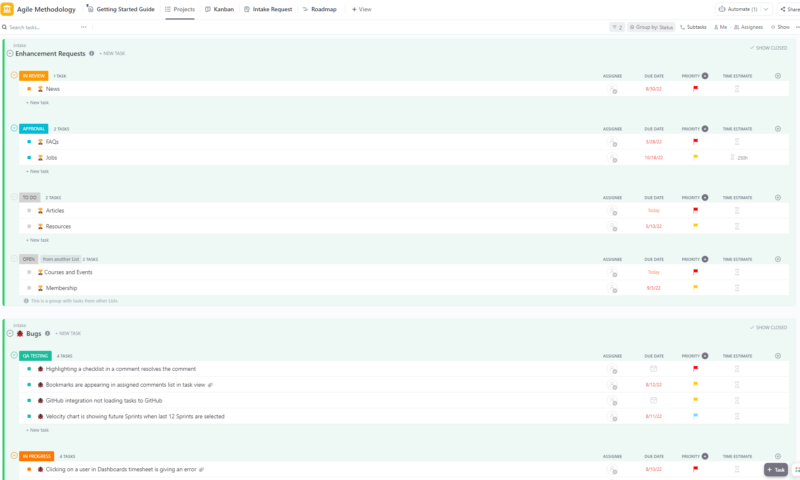
monday.com is similar in features to ClickUp. You’ll find numerous task and resource management tools, time-tracking tools, integrations and automations, solid security features, mobile and desktop apps, and robust admin tools. There are fewer communication and collaboration tools on monday.com, and the free plan is weaker, but there’s still enough to impress.
The platform has expanded beyond general project management with specialized solutions for specific industries, including construction management and service delivery. These industry-tailored workspaces come with prebuilt templates and workflows designed to address unique challenges in these sectors.
What’s more, monday.com showcased its commitment to product development at its 2024 Elevate world tour, where it introduced several upcoming features focused on AI-assisted workflows and enhanced cross-team collaboration tools. This regular cadence of major feature releases demonstrates the platform’s continuous improvement.
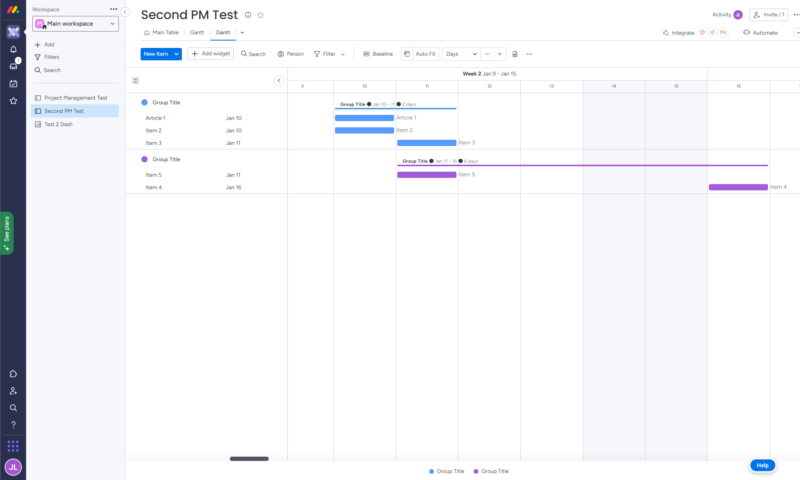
There’s little difference between ClickUp and monday.com in terms of overall features, and both platforms are loaded with everything modern teams need to complete their work. The interfaces, which we’ll cover later, are the biggest difference between the two.
Both platforms also offer custom fields functionality, allowing teams to add specialized data points to their tasks and projects for better organization and filtering. If you need a feature-packed project management tool, it’s hard to go wrong with either platform.
Workflow and Collaboration Tools
A project management tool is nothing without powerful views and task management features that allow you to work on simple and complex projects, assign tasks, track projects and more.
Fortunately, both ClickUp and monday.com have you covered no matter what project methodology you use. They each support Agile methodology with sprint planning capabilities, making them suitable for development teams using Scrum or Kanban frameworks.
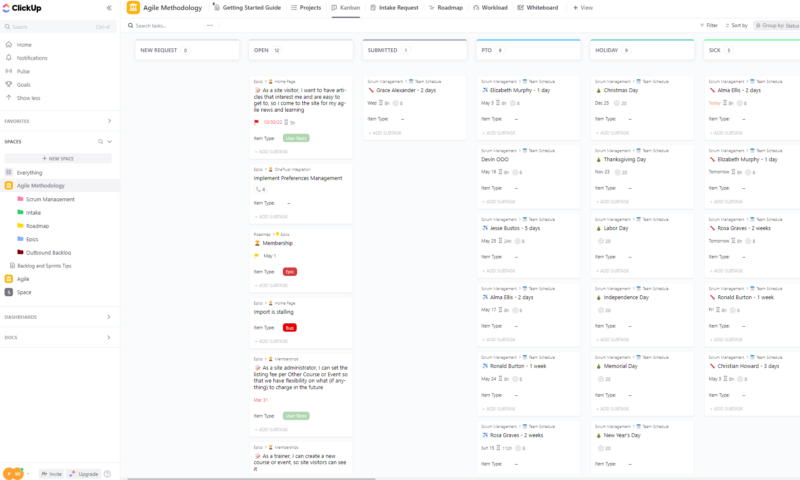
ClickUp is loaded with tools. Use ClickUp, and you’ll have access to kanban boards, Gantt charts, lists, calendars and timelines. In addition, there are customizable dashboards, workload views that let you better manage resource allocation, and comprehensive spreadsheet functionality.
These tools help managers assign the right team members to tasks based on availability, skills and workload, allowing you to track project progress, assign tasks and manage multiple teams efficiently.
If you’re after good-looking and customizable spreadsheets though, check out the guide we wrote comparing ClickUp vs Airtable.
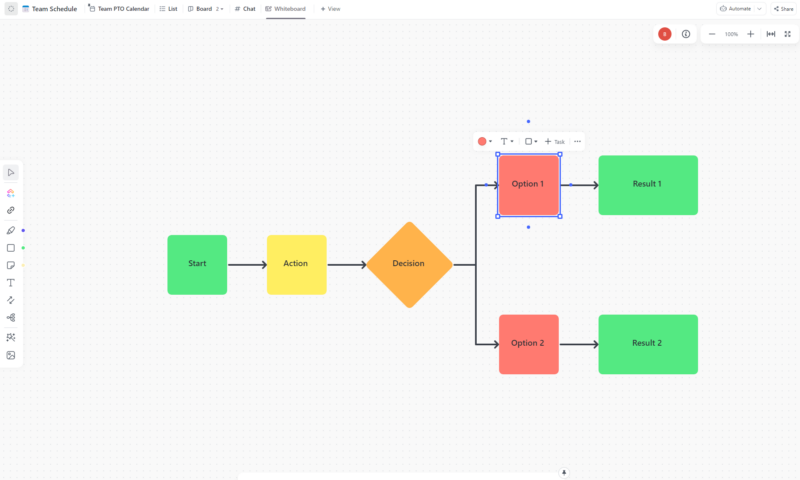
ClickUp also has robust team collaboration tools, like whiteboards and mind maps. While they aren’t the easiest to master, they’ll help you break down and plan your projects. There are powerful real-time chat and document editing functions along with in-app video recording tools. You can also upload and share images and documents with your team effortlessly. ClickUp has a little of everything for everyone.
The platform even offers a recurring tasks overview dashboard that lets project managers edit and manage all recurring tasks in one centralized location, making it easier to maintain consistent workflows across projects. This feature is particularly valuable for teams that rely heavily on repetitive tasks and regular project cycles.
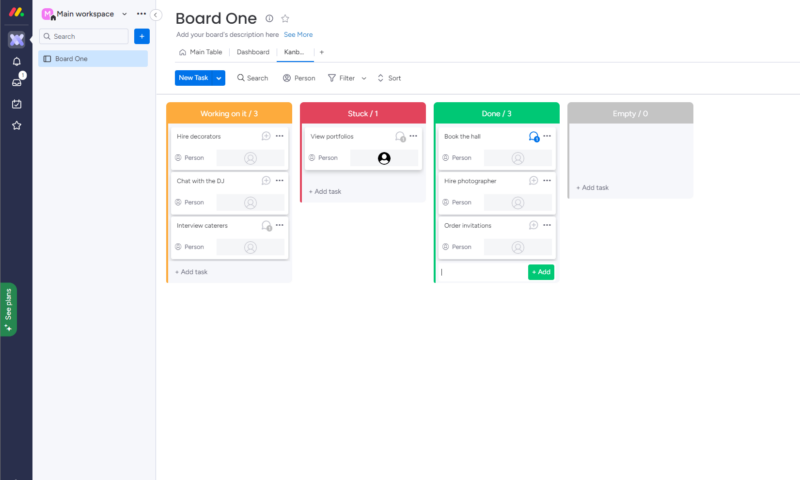
monday.com is no slouch in the tools area, either. The platform has wonderful kanban boards, easy-to-use Gantt charts and information-dense customizable monday.com dashboards. Other views include the monday.com calendar, workload, map, chart and timeline views. No matter how you and your team like to work, you’ll find workflow tools that dazzle.
The activity log deserves special mention as it provides a detailed history of all project changes, making it easy to track updates to tasks. The log retention period varies by plan (from one week in the free tier to five years in Enterprise), allowing teams to maintain comprehensive audit trails of all project activities and decisions.
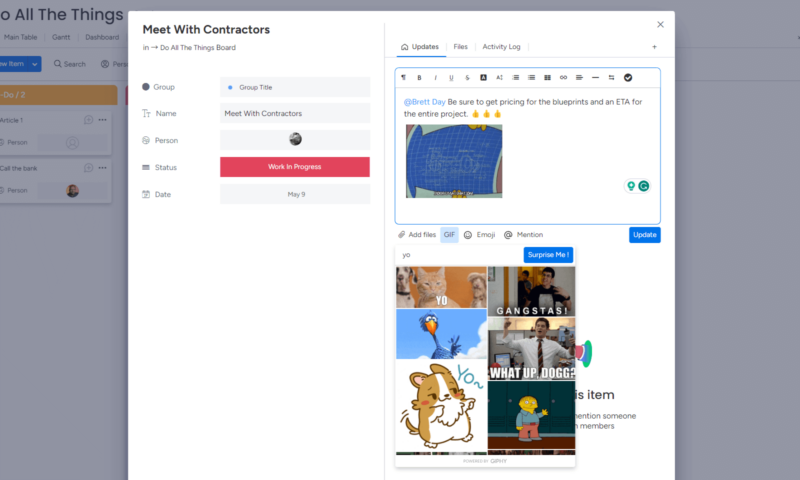
monday.com has taken a quality-over-quantity approach to collaboration tools. You’ll find whiteboards and a real-time document collaboration tool that lets you work with other team members. However, there’s no real-time chat functionality in monday.com. Still, the commenting system is robust and supports GIFs and emojis, and from the Standard plan and up, you can integrate Zoom into the software.
While ClickUp has built-in whiteboards and mind maps, monday.com’s WorkCanvas integration is a specialized tool for visual collaboration that some teams may find more comprehensive for creative planning sessions. It provides visual collaboration capabilities for teams who need to brainstorm and create project maps, flow charts, organization maps and mind maps.
ClickUp offers native Scrum management features including sprint planning, burndown charts and velocity tracking, while monday.com supports Scrum processes through specialized templates and boards. What’s more, both platforms feature workload management tools that help prevent team burnout by visualizing each member’s capacity and distributing tasks more evenly.
Any project manager who is looking for a platform to work on multiple projects across several project boards will be happy with the feature sets of both ClickUp and monday.com.
Integrations and Automations
As powerful as ClickUp and monday.com are, project managers and teams often need to use other software platforms concurrently. Fortunately, both monday.com and ClickUp allow for integrations. Both platforms offer roughly 50 native integrations each, and both allow teams to use Zapier to create integrations and automations with over 1,000 apps.
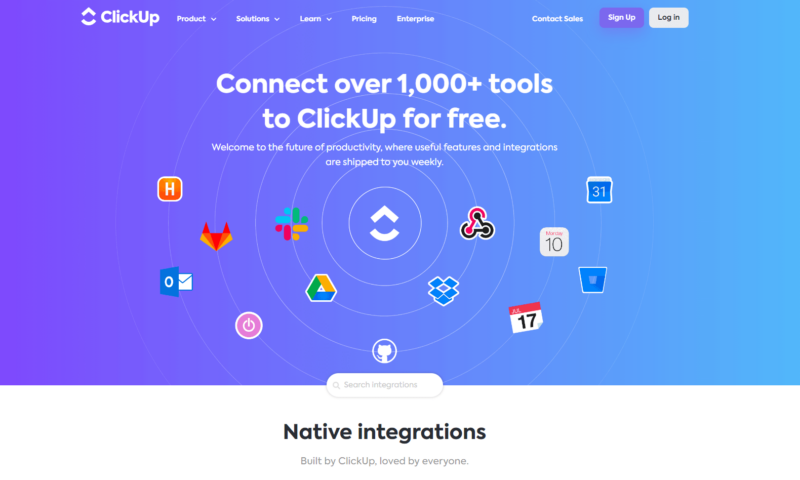
In ClickUp, you’ll find native support for Slack, Harvest, Google Drive, Dropbox, OneDrive, multiple calendar apps, Zoom, Microsoft Teams and more. You will have to pay attention to your plan’s restrictions, as some integrations can only be used in certain tiers, which is a shame, but that’s where the Zapier support comes in.
monday.com significantly expanded its sales technology ecosystem in 2025, adding deeper CRM integrations and revenue intelligence platforms. These additions are particularly valuable for teams using monday.com for sales pipeline management alongside project management tasks.
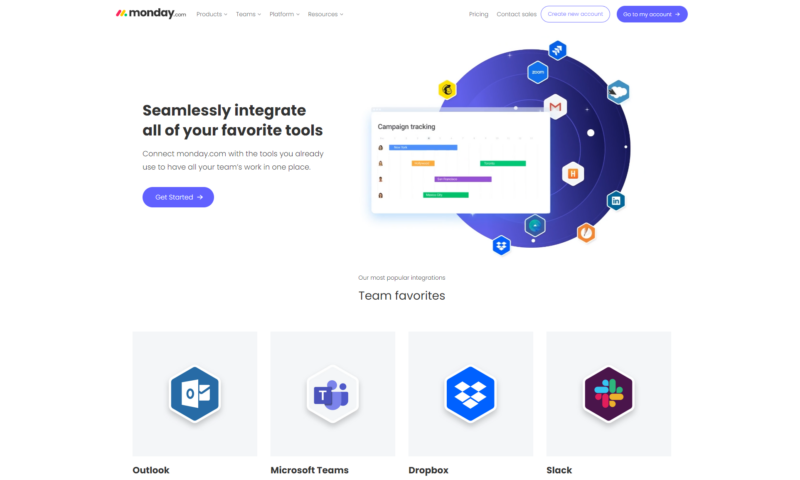
Most major apps have native monday integrations. You’ll find everything listed above and more. The biggest caveat with monday.com is that those native integrations aren’t available unless you subscribe to at least the Standard plan, so again, Zapier will be your friend. Still, in terms of the integration count and ease of implementation, monday.com and ClickUp are identical.
For more technical teams, both monday.com and ClickUp provide API access, enabling developers to build custom integrations and extend platform functionality.
Both platforms offer task automation capabilities that eliminate repetitive work. ClickUp’s automation system allows for complex task dependencies and status changes, while monday.com’s visual automations make setup intuitive for non-technical users.
Knowledgebase and Tutorials
If you’re new to project management software, you’ll likely dip your toes into the platform’s training materials. After using the knowledgebases of both monday.com and ClickUp, we can tell you that both services excel in the training department.
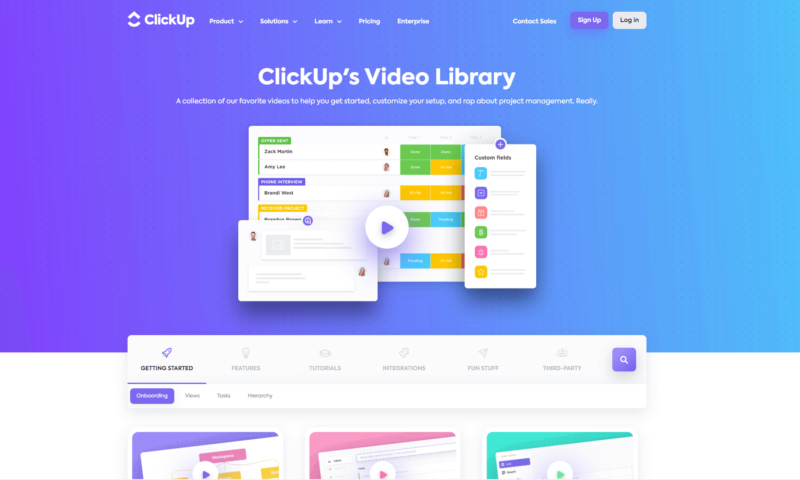
Although ClickUp isn’t the easiest software to learn, the training materials are solid. ClickUp University can help quickly bring you up to speed, while a series of colorful, energetic videos and well-written articles in the knowledgebase can guide you through sticking points. Depending on your plan, there are also admin webinars and onboarding seminars.
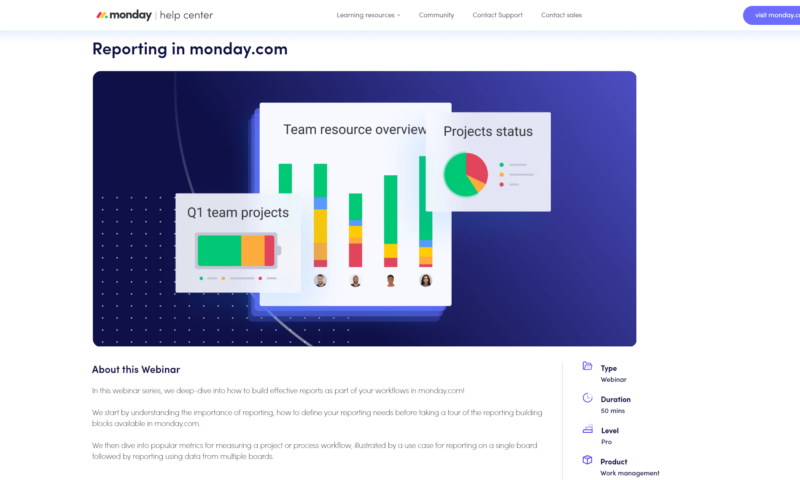
monday.com’s training materials are some of the best we’ve seen. All users get access to the self-serve knowledgebase and live webinars. There’s a comprehensive monday.com training academy and numerous articles and video guides, too. Overall, monday.com’s training materials are stellar.
Moreover, enterprise clients on both platforms receive access to a dedicated customer success manager who provides personalized onboarding assistance and ongoing support.
Both monday.com and ClickUp have done a fantastic job with their training materials. You’ll have no problems learning how to use either platform.
Security and Privacy
In this day and age, security is critical. Thankfully, you don’t have anything to worry about with monday.com or ClickUp, as they both have strong security measures in place.
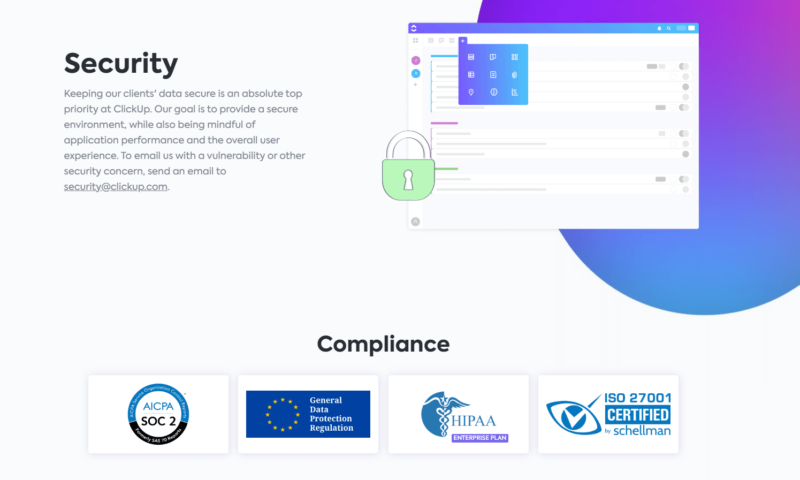
ClickUp uses TLS 1.2 and AES-256 encryption to keep your data secure while sitting on, and in transit from, Amazon Web Services servers. It’s also SOC 2 compliant and has numerous ISO certifications. ClickUp even offers multiple single sign-on methods, two-factor authentication, custom SAML sign-on, session management and more across its plans.
What’s more, ClickUp provides regional data hosting options in Australia, Singapore and Europe, which helps meet various regional data protection regulations while potentially improving data access speeds for users in those regions. This feature is particularly valuable for global organizations that must comply with specific jurisdictional requirements regarding data storage and processing.
Both platforms support third-party authentication methods — ClickUp offers multiple single sign-on options across all plans, while monday.com reserves Google authentication for Pro plan users and above.
In addition, each platform implements role-based access control (RBAC), allowing administrators to precisely define what actions and data different team members can access based on their role.
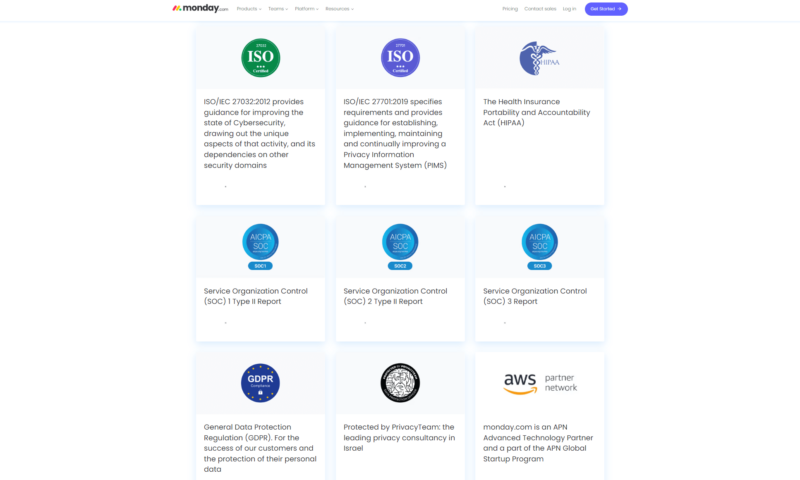
monday.com offers similar protections. Amazon Web Services servers will hold your data. The same TLS 1.2 and AES-256 encryption methods are used. monday.com is SOC 2 compliant and holds many ISO certificates. Two-factor authentication is available to everyone, but Google authentication is reserved for the Pro plan and up. Only Enterprise members can use single sign-on methods.
Additionally, monday.com has enhanced its infrastructure with the release of mondayDB 1.0, a new data infrastructure designed specifically for improved performance, scalability and flexibility. This upgrade benefits all customers with faster response times and better handling of complex workflows, which is particularly important for enterprise users managing large-scale projects.
Desktop and Mobile Applications
If you like working on the go, you’ll be pleased to know that ClickUp and monday.com made our roundups of the best project management software for macOS and for Windows. Below, we’ll detail why.
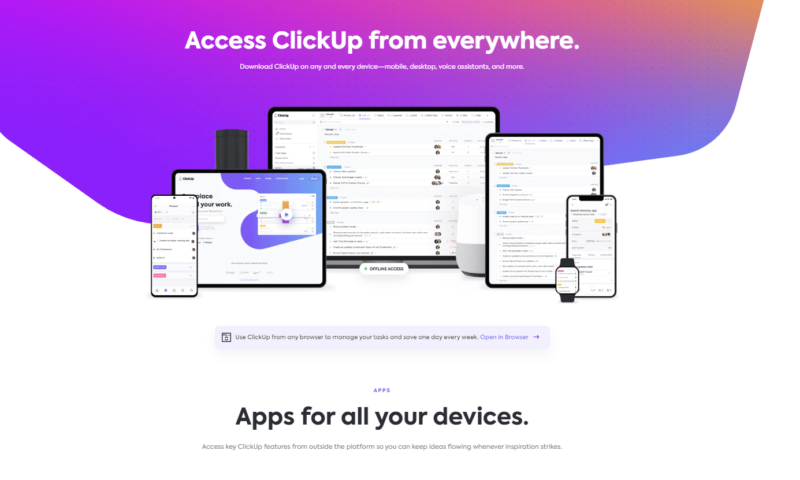
ClickUp offers native desktop apps for Windows, macOS and Linux, and also provides mobile apps for Apple’s watchOS, iOS and Android devices. The desktop apps are flawless and identical to the web version.
However, the mobile apps, while OK, could be better. You can access many views and tools on your phone or tablet and perform basic task management duties, but touch implementation is poor.
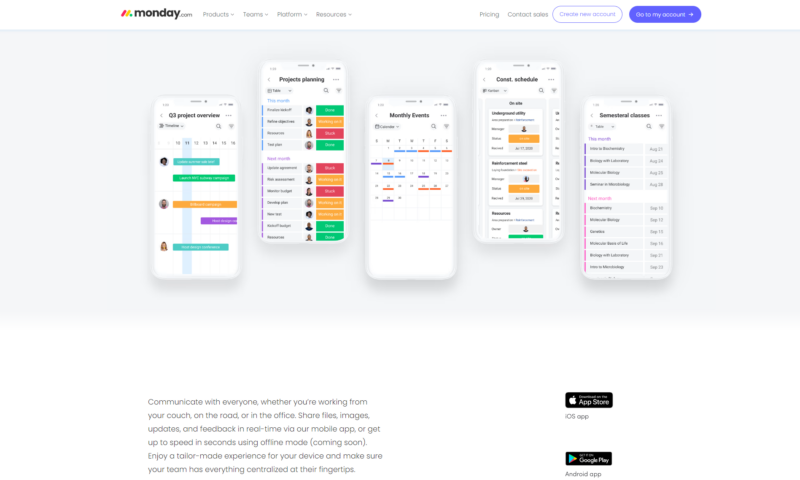
Similarly, monday.com offers native desktop apps for Windows and macOS alongside mobile apps for iOS and Android. The desktop apps are loaded with every tool and are slick when in use. The mobile apps allow you to see tasks, add due dates, comment, move tasks around and more, but views are limited. However, touch functions are flawless, making the app user-friendly.
Differences
Now that we’ve looked at the many similarities between ClickUp and monday.com, we’ll look at the features that set these two project management juggernauts apart. Pay attention here, as the differences could sway you one way or the other.
User-Friendliness
Time is money, and the clock to your next deadline is always ticking, so the software you choose must be easy to learn and use. While no software is impossible to get to grips with, some platforms are certainly easier to use than others — this is the case with ClickUp and monday.com.
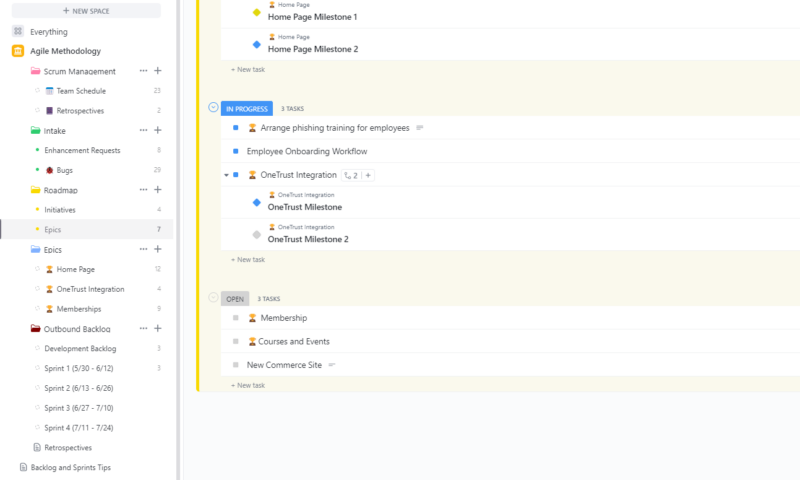
One of ClickUp’s downsides is its user interface. ClickUp offers users a sterile, utilitarian look with a subdued color palette that doesn’t always please the eyes. Navigation is hampered by multiple collapsible menus that aren’t always intuitive, and many advanced tools, like whiteboards and mind maps, lack finesse and can be frustrating to use.
It’s not all doom and gloom, though. We like the persistent navigation bar above the main workspace, and accessing advanced options is straightforward. The task management tools are easy to use, too.
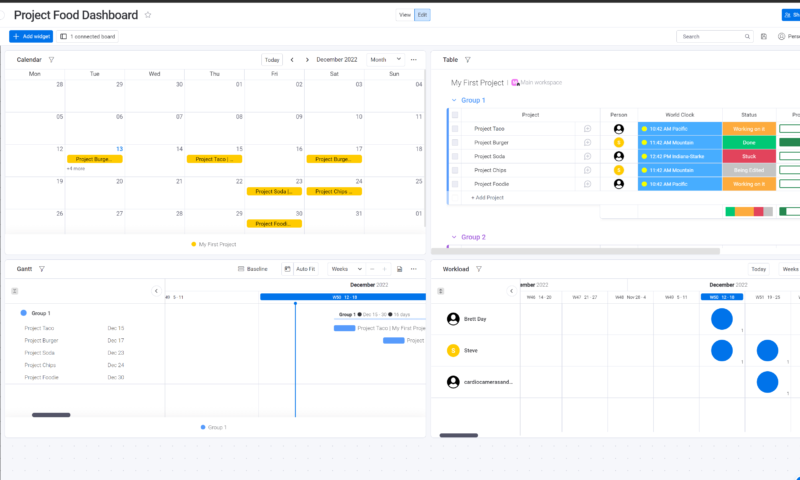
On the other hand, monday.com has the nicest, most user-friendly interface in the industry. All the tools are simple and intuitive. The color palette is bright, bold and pleasant to look at. Every major tool or option is front and center in clean, concise menus, which makes navigation quick. Fire up monday.com, and you can hit the ground running with minimal fuss.
It’s worth mentioning that ClickUp and monday.com both provide in-app notifications to keep team members informed about task assignments, mentions and updates. However, ClickUp’s notification system can sometimes feel overwhelming with its level of detail.
After some time, you’ll find ClickUp to be a fine tool, but you’ll have to set aside time to become comfortable with it. If you want a more plug-and-play option, monday.com is the way to go.
Pricing and Plans
The costs of monday.com and ClickUp are quite different. ClickUp offers a generous free plan that gives access to multiple views, integrations, and collaboration and communication tools. You’ll also get access to mobile apps, time tracking, sprints and basic security features. Unlimited members, custom views and tasks are also supported. The only caveat is that some tools have limited uses per month.
The free version of monday.com (the Individual plan) is poor. The plan supports two members and three boards with only eight column types and 200 monday.com templates. You can access mobile apps and unlimited messages and updates. The plan also has shareable forms, embedded documents, one dashboard, a kanban board, and basic security.
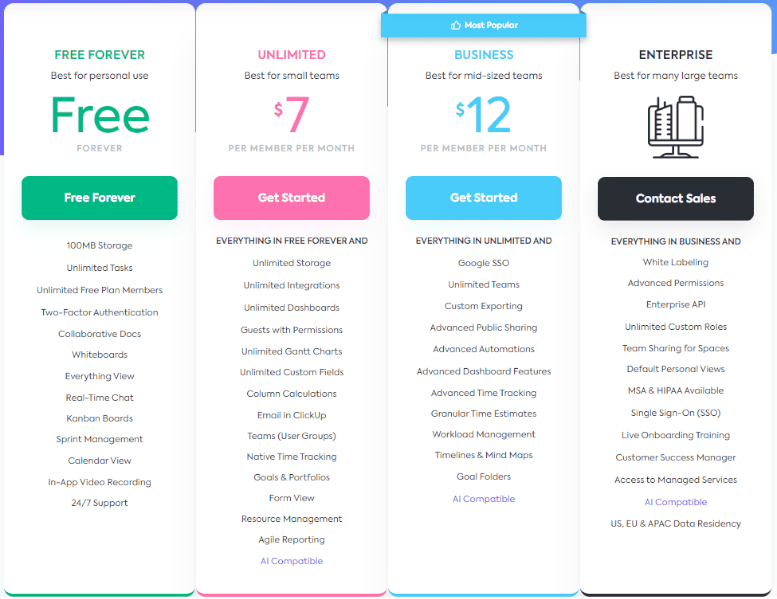
ClickUp’s Unlimited plan costs $7 per user per month when paid annually and $10 per user per month when billed monthly. monday’s comparable Basic plan is $9 per user per month billed yearly and $12 per user per month with monthly payments.
Business Plans
Next is ClickUp’s Business plan, which costs $12 per user per month when paid annually and $19 per user per month when paid monthly. monday’s Standard plan, which is a value leader, costs $12 per user per month if you pay yearly and $14 per user per month if you pay every month.
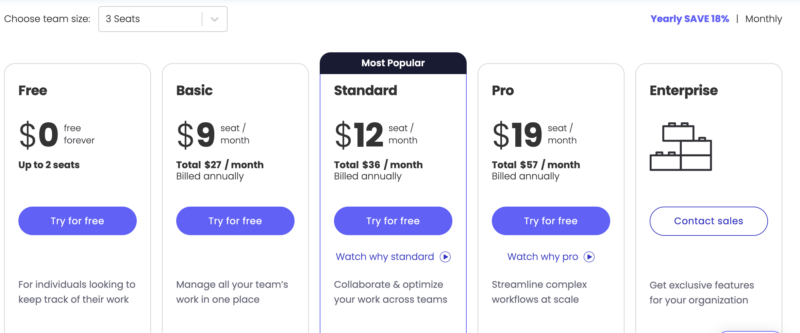
monday’s Pro plan comes in at $19 per user per month with yearly billing and $24 per user paid monthly. Scalable Enterprise plans that include white labeling options are also available, allowing businesses to customize the platform with their own branding, while ClickUp offers this feature in its Business plan.
It must be noted that monday.com requires a three-person minimum in each paid plan. Even still, it offers better value. In fact, hardly any platforms beat monday’s Standard and Pro plans for value. If you’d like a more detailed look at ClickUp and monday.com’s pricing and plan structures, take a look at our ClickUp pricing guide and our monday.com pricing guide.
Which Is Better: ClickUp VS monday.com?
According to our thorough examination, monday.com is better than ClickUp. Still, both platforms are great at what they do, and only you can decide which is best for you and your team.
We Recommend monday.com If You Want…
- To hit the ground running: monday.com is the most user-friendly platform in the industry, thanks to its slick, easy-to-navigate interface and fuss-free tools.
- To keep your accounting team happy: monday’s Standard and Pro plans have one of the best feature-to-cost ratios of any platform.
- Extreme versatility: monday.com has all the tools needed (kanban boards, Gantt charts and lists) to support workflows, including Agile, the Waterfall method and more.
We Recommend ClickUp If You Want…
- Lots of collaboration tools: ClickUp provides users with many real-time tools that can help teams work together.
- To save money: ClickUp has one of the best free plans in the industry, so if you can get by with it, you can save a lot of cash.
- To work on a variety of projects: ClickUp’s task management tools make it ideal for software development teams, creative groups, engineering teams and beyond.
If You Want to Consider Other Services, Check Out…
- 1
- 2
- 3
- 4
- 5
The Verdict: Why We Think monday.com Wins Overall
Of the two project management solutions covered, for us, monday.com is the overall winner. Thanks to its better price-to-features ratio, easy-to-use tools and clean user interface, we believe it’s the better choice for most teams. Just sign up and you’re ready to start managing projects.
Additionally, a Total Economic Impact study conducted by Forrester Consulting demonstrated significant ROI for organizations implementing monday.com, with particular benefits in reduced administrative overhead and improved cross-team collaboration. This independent validation supports monday.com’s value proposition for mid-to-large organizations.
Both monday.com and ClickUp offer free trials, so don’t be afraid to take either platform for a no-risk spin. What do you think about monday.com and ClickUp? Have you used them? Which platform do you like better? Let us know in the comments, and as always, thank you for reading.
FAQ
We have spent a lot of time with both platforms, and after extensive testing, we have concluded that monday.com is the better software thanks to its easy-to-use tools, no-fuss interface and robust plans that won’t break the bank.
ClickUp is a powerful tool designed with a particular type of user in mind (software and programming). ClickUp can still be used in many work fields, but monday.com is a much more well-rounded tool that’s suited to many tasks.
ClickUp and monday.com have a lot in common. They’re designed to do similar things (plan, execute, track and complete tasks), but they have a few subtle differences that make them suitable for different types of projects.




